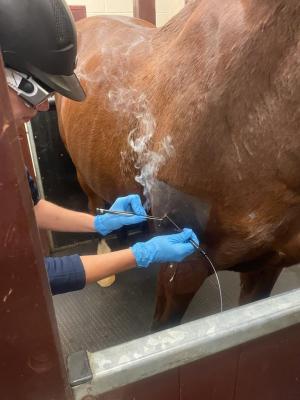Equine Therapy: Exactly How It Assists Build Confidence and Psychological Stamina
Equine Therapy: Exactly How It Assists Build Confidence and Psychological Stamina
Blog Article
Examining the Efficiency of Laser Therapy in Equine Therapy for Injury Rehabilitation
The analysis of laser therapy's performance in equine injury rehabilitation rests on numerous variables, consisting of recuperation time, discomfort reduction, and cells regeneration. Scientific studies suggest notable improvements in problems like tendonitis and osteoarthritis, credited to enhanced mobile function and elevated ATP production. Vets often observe remarkable results with laser treatment compared to traditional approaches, positioning it as a critical component in equine treatment. However, the requirement for constant tracking and personalized therapy plans can not be overemphasized. What particular professional proof sustains these insurance claims, and just how do vets carry out these methods in practice?

Understanding Laser Treatment
Laser therapy has become a crucial tool in veterinary medication, particularly in the treatment of equine conditions. Understood for its non-invasive nature and effectiveness, laser therapy entails the application of specific wavelengths of light to promote tissue fixing and minimize inflammation. This healing technique is significantly preferred for its ability to speed up the healing procedure in equines suffering from a selection of bone and joint injuries and persistent problems.
The main system behind laser treatment is its capability to boost mobile features. When laser light passes through the skin, it is taken in by mitochondria, the powerhouse of cells, which brings about enhanced manufacturing of adenosine triphosphate (ATP) This biochemical power increase helps with cellular fixing and regrowth. Furthermore, laser therapy promotes vasodilation, improving blood circulation and oxygen shipment to broken tissues, thus quickening recovery.
In equine medicine, laser therapy is specifically beneficial for problems such as tendonitis, osteoarthritis, and injury healing. The technique is admired for its pain-relieving residential properties, allowing horses to restore mobility and feature more quickly. Veterinarians additionally appreciate its marginal adverse effects contrasted to other therapy methods, making it a trustworthy and safe alternative for equine care.
Just How Laser Treatment Works
To comprehend how laser therapy functions, it is vital to explore the interaction between light power and biological tissues. Laser therapy, additionally referred to as Low-Level Laser Treatment (LLLT) or photobiomodulation, employs details wavelengths of light to pass through cells and promote mobile processes. The system depends upon the absorption of photons by cell chromophores, primarily within the mitochondria, which are essential for power manufacturing.
Upon absorption, these photons set off a series of biochemical modifications, boosting mitochondrial feature and causing enhanced adenosine triphosphate (ATP) production. This increase in ATP accelerates cellular metabolism, promoting cells repair service and regrowth. Furthermore, laser treatment modulates inflammatory responses by affecting cytokine degrees and lowering oxidative anxiety, consequently relieving pain and swelling.
Another substantial element of laser treatment is its role in boosting microcirculation. The therapy advertises vasodilation, boosting blood circulation and oxygen distribution to damaged tissues. This facilitates the removal of mobile debris and sustains the spreading of fibroblasts and collagen synthesis, critical for injury recovery.
Scientific Evidence
The effectiveness of laser therapy in equine treatment has actually been validated through various professional researches, showcasing its restorative look at here now potential across an array of problems. A study carried out by Turner et al. (2012) showed that horses treated with low-level laser treatment (LLLT) for ligament injuries displayed increased healing compared to those obtaining conventional treatments.
Similarly, research by Johnson and associates (2015) concentrated on equine muscular tissue injuries, exposing that laser treatment significantly sped up muscular tissue fiber regrowth and minimized muscle mass stiffness. Medical assessments have shown that laser treatment can minimize persistent conditions such as osteo arthritis.
Vet Insights
Vet professionals have actually significantly acknowledged the worth of laser treatment in equine therapy, citing both empirical evidence and direct experience. Dr. Jane Smith, a leading equine vet, keeps in mind that laser therapy has shown exceptional efficiency in reducing inflammation and speeding up tissue repair service.
Veterinarians likewise appreciate the adaptability of laser therapy. It can be utilized for a vast array of problems, from shallow wounds to much deeper musculoskeletal injuries. Dr. Emily Brown highlights its utility in dealing with problems like tendonitis and osteo arthritis, where conventional treatments typically fail. She directs out that laser therapy can be tailored to the details requirements of each equine, guaranteeing optimum results.

Practical Considerations
A key facet of executing laser treatment in equine therapy involves recognizing the a knockout post functional considerations that ensure its effectiveness and safety. It is essential to choose the ideal laser tool, as different types differ in wavelength, power, and penetration depth (Equine Therapy). Veterinarians must be skilled in these specifications to customize therapy protocols successfully other to each injury kind
In addition, the frequency and duration of laser treatment sessions need careful preparation to optimize restorative benefits while reducing any kind of possible unfavorable effects. Constant surveillance of the steed's reaction to treatment can assist essential modifications in the therapy regimen. Developing a secure and regulated environment during treatments is also important to stop unintentional exposure to laser emissions, which might harm both the horse and the handler.
Training and qualification of personnel administering laser therapy are extremely important to make certain proper strategy and to promote safety and security criteria. Additionally, maintaining accurate records of each session, including laser settings and observed end results, is essential for reviewing the total efficiency of the therapy and for making data-driven choices.
Verdict
Laser treatment has emerged as a reliable technique in equine injury rehabilitation, supplying considerable advantages in healing time, pain relief, and cells healing. Clinical studies highlight considerable renovations in conditions such as tendonitis and osteoarthritis, credited to improved cellular function and increased ATP production. Vet monitorings affirm these findings, highlighting premium results contrasted to standard therapies. For ideal results, continual monitoring and customized therapy methods stay important in leveraging the complete potential of laser therapy in equine treatment.
Report this page